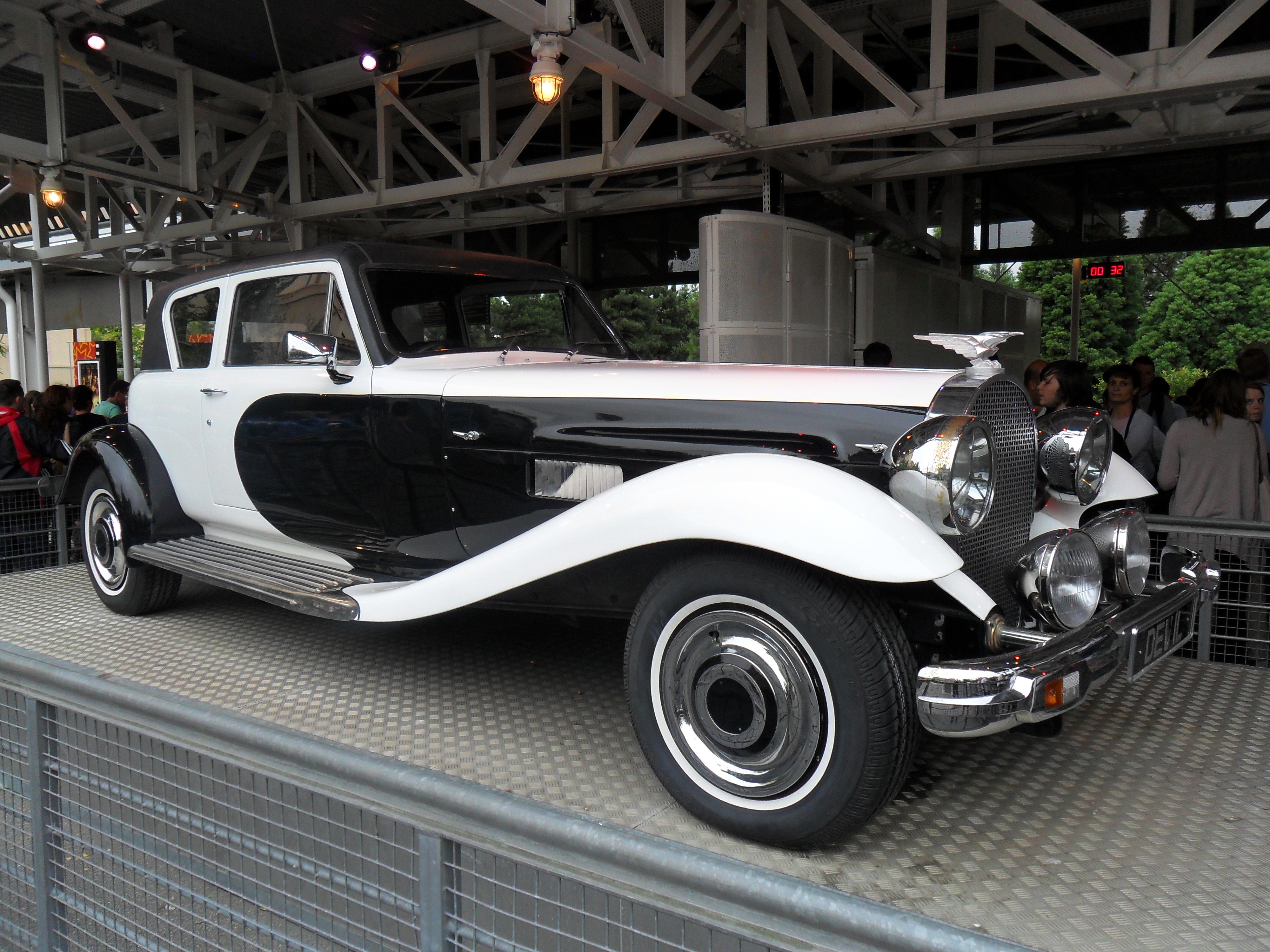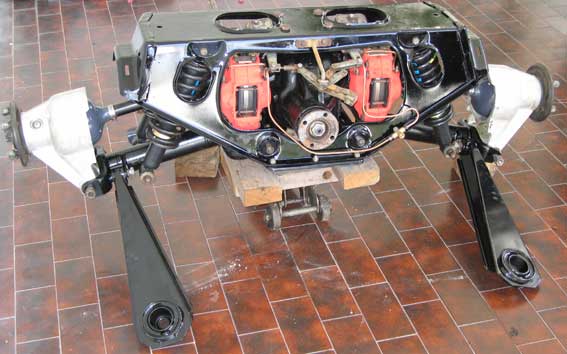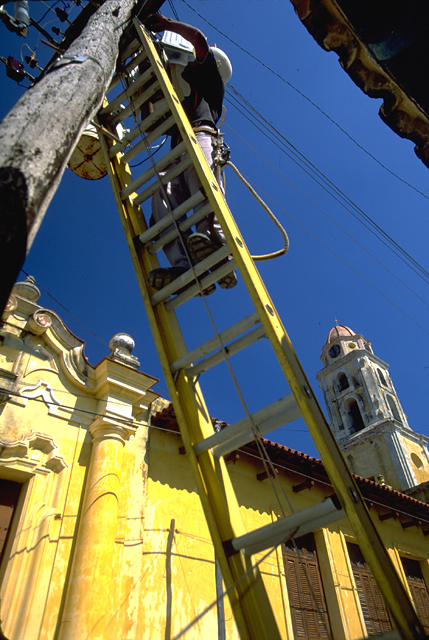|
Panther De Ville
The Panther De Ville is a neo-classic luxury vehicle which was produced by Panther Westwinds, a British speciality car maker, from 1974 to 1985. The De Ville was conceived by Robert Jankel to appeal to the taste of nouveau riche customers, including singer Elton John and actor Oliver Reed. About 60 De Villes were hand-built, including eleven two-door convertibles (for many years Britain's most expensive listed production car), and one pink and gold six-door limousine. With a wheelbase of , the tubular-framed De Ville used a straight-six engine or a V12 engine from Jaguar Cars. The flowing wing lines and big headlights of the De Ville were styled to imitate the Bugatti Royale. The cockpit of the De Ville was modern, without the exterior's pretense of pre-war styling. The Panther De Ville was equipped with Jaguar suspension, power steering and automatic transmission, so it was an easy car to drive and quite quick, although poor aerodynamics tended to keep the top speed l ... [...More Info...] [...Related Items...] OR: [Wikipedia] [Google] [Baidu] |
Panther Westwinds
Panther Westwinds (commonly known as Panther) was a manufacturer of niche sports cars and luxury cars, based in Surrey, United Kingdom. History Founded in 1972 by Robert Jankel, the Panther company initially manufactured retro-styled cars based on the mechanical components of standard production cars from other manufacturers. The Panther Lima bodyshell was manufactured from fibreglass, by Industrial Marine Fibreglass (IMF), who were based on the Milber Industrial Estate, Newton Abbot, Devon. Other examples of cars manufactured by Panther included 1975's Panther Rio, Rio: based on the Triumph Dolomite, but appointed to "Rolls-Royce Motors, Rolls-Royce standards" — the cost of which was equivalent to three Triumph Dolomites. Another model was the three-axled Panther 6 of which only two were ever manufactured. During the late 1970s, the company was engaged in developing a hovercraft using a pair of Honda Gold Wing, 1000cc motorcycle engines; one for the lift fan and one for ... [...More Info...] [...Related Items...] OR: [Wikipedia] [Google] [Baidu] |
Customer
In sales, commerce, and economics, a customer (sometimes known as a client, buyer, or purchaser) is the recipient of a good, service, product or an idea - obtained from a seller, vendor, or supplier via a financial transaction or exchange for money or some other valuable consideration. Etymology and terminology Early societies relied on a gift economy based on favours. Later, as commerce developed, less permanent human relations were formed, depending more on transitory needs rather than enduring social desires. Customers are generally said to be the purchasers of goods and services, while clients are those who receive personalized advice and solutions. Although such distinctions have no contemporary semantic weight, agencies such as law firms, film studios, and health care providers tend to prefer ''client'', while grocery stores, banks, and restaurants tend to prefer '' customer'' instead. Clients The term client is derived from Latin ''clients'' or ''care'' meaning "to ... [...More Info...] [...Related Items...] OR: [Wikipedia] [Google] [Baidu] |
Aerodynamics
Aerodynamics, from grc, ἀήρ ''aero'' (air) + grc, δυναμική (dynamics), is the study of the motion of air, particularly when affected by a solid object, such as an airplane wing. It involves topics covered in the field of fluid dynamics and its subfield of gas dynamics. The term ''aerodynamics'' is often used synonymously with gas dynamics, the difference being that "gas dynamics" applies to the study of the motion of all gases, and is not limited to air. The formal study of aerodynamics began in the modern sense in the eighteenth century, although observations of fundamental concepts such as aerodynamic drag were recorded much earlier. Most of the early efforts in aerodynamics were directed toward achieving Aircraft#Heavier than air – aerodynes, heavier-than-air flight, which was first demonstrated by Otto Lilienthal in 1891. Since then, the use of aerodynamics through mathematical analysis, empirical approximations, wind tunnel experimentation, and computer simu ... [...More Info...] [...Related Items...] OR: [Wikipedia] [Google] [Baidu] |
Automatic Transmission
An automatic transmission (sometimes abbreviated to auto or AT) is a multi-speed transmission used in internal combustion engine-based motor vehicles that does not require any input from the driver to change forward gears under normal driving conditions. It typically includes a transmission, axle, and differential in one integrated assembly, thus technically becoming a transaxle. The most common type of automatic transmission is the hydraulic automatic, which uses a planetary gearset, hydraulic controls, and a torque converter. Other types of automatic transmissions include continuously variable transmissions (CVT), automated manual transmissions (AMT), and dual-clutch transmissions (DCT). An electronic automatic transmission (EAT) may also be called an electronically controlled transmission (ECT), or electronic automatic transaxle (EATX). A hydraulic automatic transmission may also colloquially called a " slushbox" or simply a "torque converter", although the latter term c ... [...More Info...] [...Related Items...] OR: [Wikipedia] [Google] [Baidu] |
Power Steering
A power steering is a mechanical device equipped on a motor vehicle that helps drivers steer the vehicle by reducing steering effort needed to turn the steering wheel, making it easier for the vehicle to turn or maneuver at lower speeds. Hydraulic or electric actuators add controlled energy to the steering mechanism, so the driver can provide less effort to turn the steered wheels when driving at typical speeds, and reduce considerably the physical effort necessary to turn the wheels when a vehicle is stopped or moving slowly. Power steering can also be engineered to provide some artificial feedback of forces acting on the steered wheels. Hydraulic power steering systems for cars augment steering effort via an actuator, a hydraulic cylinder that is part of a servo system. These systems have a direct mechanical connection between the steering wheel and the linkage that steers the wheels. This means that power-steering system failure (to augment effort) still permits the vehicle ... [...More Info...] [...Related Items...] OR: [Wikipedia] [Google] [Baidu] |
Jaguar Independent Rear Suspension
Jaguar's independent rear suspension (IRS) unit has been a common component of a number of Jaguar production cars since 1961, passing through two major changes of configuration up to 2006 and last used in the Jaguar XK8 and Aston Martin DB7. This article concentrates on the first generation Jaguar IRS, which firmly established the marque's reputation for suspension sophistication, combining as it did smooth ride with excellent roadholding and low levels of noise, vibration, and harshness (NVH). The two generations overlap in time due to their being used in both full size and sports models that were updated at different times. First generation IRS (1961–1986) Development When first introduced, it was relatively rare for British cars to have independently sprung rear wheels,Harvey, C. (1977) ''E-Type: End of an Era'', Haynes, Yeovil. most production cars of the time using live axles. Independent suspension systems offer the advantage of lower unsprung mass to improve roadh ... [...More Info...] [...Related Items...] OR: [Wikipedia] [Google] [Baidu] |
Bugatti Type 41
41 may refer to: * 41 (number) * one of the years 41 BC, AD 41, 1941, 2041 Art and entertainment * ''41'' (film), a 2007 documentary about Nicholas O'Neill, the youngest victim of the Station nightclub fire * ''41'', a 2012 film by Glenn Triggs * ''41'', a 2012 documentary about President George H. W. Bush. * "#41" (song), a song by the Dave Matthews Band * ''Survivor 41'', the 41st installment of CBS's reality program ''Survivor'' * "Forty One", a song by Karma to Burn from the album ''Appalachian Incantation'', 2010 People * George H. W. Bush, or "Bush 41" (to distinguish him from his son, George W. Bush), 41st president of the United States * Nick "41" MacLaren, member of the New Zealand hip hop duo Frontline See also * HP-41C, a series of calculators made by Hewlett-Packard ** FOCAL (Hewlett-Packard) The HP-41C series are programmable, expandable, continuous memory handheld RPN calculators made by Hewlett-Packard from 1979 to 1990. The original model, HP-41C, was the ... [...More Info...] [...Related Items...] OR: [Wikipedia] [Google] [Baidu] |
Jaguar Cars
Jaguar (, ) is the luxury vehicle brand of Jaguar Land Rover, a British multinational car manufacturer with its headquarters in Whitley, Coventry, England. Jaguar Cars was the company that was responsible for the production of Jaguar cars until its operations were fully merged with those of Land Rover to form Jaguar Land Rover on 1 January 2013. Jaguar's business was founded as the Swallow Sidecar Company in 1922, originally making motorcycle sidecars before developing bodies for passenger cars. Under the ownership of S. S. Cars Limited, the business extended to complete cars made in association with Standard Motor Co, many bearing ''Jaguar'' as a model name. The company's name was changed from S. S. Cars to Jaguar Cars in 1945. A merger with the British Motor Corporation followed in 1966, the resulting enlarged company now being renamed as British Motor Holdings (BMH), which in 1968 merged with Leyland Motor Corporation and became British Leyland, itself to be nationali ... [...More Info...] [...Related Items...] OR: [Wikipedia] [Google] [Baidu] |
V12 Engine
A V12 engine is a twelve-cylinder piston engine where two banks of six cylinders are arranged in a V configuration around a common crankshaft. V12 engines are more common than V10 engines. However, they are less common than V8 engines. The first V12 engine was built in 1904 for use in racing boats. Due to the balanced nature of the engine and the smooth delivery of power, V12 engines were found in early luxury automobiles, boats, aircraft, and tanks. Aircraft V12 engines reached their apogee during World War II, following which they were mostly replaced by jet engines. In Formula One racing, V12 engines were common during the late 1960s and early 1990s. Applications of V12 engines in the 21st century have been as marine engines, in railway locomotives, as large stationary power as well as in some European sports and luxury cars. Design Balance and smoothness Each bank of a V12 engine essentially functions as a straight-six engine, which by itself has perfect primary and ... [...More Info...] [...Related Items...] OR: [Wikipedia] [Google] [Baidu] |
Straight-six Engine
The straight-six engine (also referred to as an inline-six engine; abbreviated I6 or L6) is a piston engine with six cylinders arranged in a straight line along the crankshaft. A straight-six engine has perfect primary and secondary engine balance, resulting in fewer vibrations than other designs of six or less cylinders. Until the mid-20th century, the straight-six layout was the most common design for engines with six cylinders. However, V6 engines became more common from the 1960s and by the 2000s most straight-six engines had been replaced by V6 engines. An exception to this trend is BMW which has produced automotive straight-six engines from 1933 to the present day. Characteristics In terms of packaging, straight-six engines are almost always narrower than a V6 engine or V8 engine, but longer than straight-four engines, V6s, and most V8s. Straight-six engines are typically produced in displacements ranging from , however engines ranging in size from the Benelli 750 ... [...More Info...] [...Related Items...] OR: [Wikipedia] [Google] [Baidu] |
Ladder Chassis
A ladder is a vertical or inclined set of rungs or steps used for climbing or descending. There are two types: rigid ladders that are self-supporting or that may be leaned against a vertical surface such as a wall, and rollable ladders, such as those made of rope or aluminium, that may be hung from the top. The vertical members of a rigid ladder are called stringers or rails (US) or stiles (UK). Rigid ladders are usually portable, but some types are permanently fixed to a structure, building, or equipment. They are commonly made of metal, wood, or fiberglass, but they have been known to be made of tough plastic. Historical usages Ladders are ancient tools and technology. A ladder is featured in a Mesolithic rock painting that is at least 10,000 years old, depicted in the Spider Caves in Valencia, Spain. The painting depicts two humans using a ladder to reach a wild honeybee nest to harvest honey. The ladder is depicted as long and flexible, possibly made out of some sort of ... [...More Info...] [...Related Items...] OR: [Wikipedia] [Google] [Baidu] |
Wheelbase
In both road and rail vehicles, the wheelbase is the horizontal distance between the centers of the front and rear wheels. For road vehicles with more than two axles (e.g. some trucks), the wheelbase is the distance between the steering (front) axle and the centerpoint of the driving axle group. In the case of a tri-axle truck, the wheelbase would be the distance between the steering axle and a point midway between the two rear axles. Vehicles The wheelbase of a vehicle equals the distance between its front and rear wheels. At equilibrium, the total torque of the forces acting on a vehicle is zero. Therefore, the wheelbase is related to the force on each pair of tires by the following formula: :F_f = mg :F_r = mg where F_f is the force on the front tires, F_r is the force on the rear tires, L is the wheelbase, d_r is the distance from the center of mass (CM) to the rear wheels, d_f is the distance from the center of mass to the front wheels (d_f + d_r = L), m is the mass ... [...More Info...] [...Related Items...] OR: [Wikipedia] [Google] [Baidu] |




.jpg)



